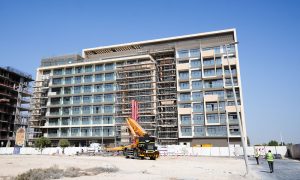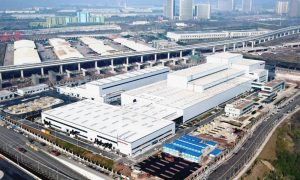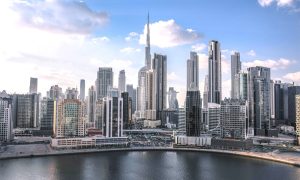A pathway to sustainability
A clear strategy highlighting the advantages of owning and operating low-carbon buildings can drive positive changes aligned with national Net Zero targets writes Atkins’ Mayuko Totsuka and Dr. Mohsenah Al Yami

The built environment contributes significantly to global carbon emissions, making it crucial to take steps towards reducing its carbon footprint. In this article, we will examine the importance of decarbonising buildings in the GCC, and the required collaborative efforts by the public and private sectors to achieve national Net Zero ambitions. Green building practices, renewable energy sources, and energy-efficient technologies play a role in meeting the 1.5-degree target – limiting the global average temperature increase to 1.5°C above pre-industrial levels.
However, the path to Net Zero buildings requires integrated planning for low-carbon communities, and the adoption of a comprehensive building decarbonisation methodology, underpinned by data-driven solutions developed to decarbonise existing building portfolios in an effective way. As the UAE will host the 28th Conference of the Parties to the UN Framework Convention on Climate Change (COP28), there is a great opportunity to drive collaboration and action plans towards mitigating climate change risks and decarbonising the built environment across the region.
National Targets in the GCC
Countries in the GCC region are taking significant initiatives to reduce their carbon footprint in the built environment by setting targets for renewable energy generation and implementing energy efficiency programs. The United Arab Emirates (UAE) has committed to generating 50% of its energy from clean sources by 2050, while the Kingdom of Saudi Arabia (KSA) has set a target to generate 50% of its electricity from renewable sources by 2030.
Qatar aims to generate 20% of its electricity from renewable energy sources by 2030. Oman has also set a goal of generating 30% of its energy from renewable sources by 2030. In Bahrain, the government has launched a program to retrofit buildings with energy-efficient technologies. In 2020, Saudi Arabia launched the concept of the circular carbon economy at the G20 summit to align fossil fuel producers’ interests with Net Zero emissions trajectories.
Master Planning of Low-Carbon Communities
The GCC region has an advantage in greenfield planning for creating sustainable and low-carbon communities. However, there has been a tendency in the region to prioritise gated communities and car-dependent lifestyles.
According to the SNC-Lavalin Group’s report on ‘Engineering Net Zero in the GCC’, a people-centric approach is necessary, considering access to community amenities and alternative modes of transportation. As the report emphasises, holistic city planning and design are required to address carbon emissions in the built environment, energy, and transport sectors.

Saudi Arabia is currently delivering megaprojects along the Red Sea coast to develop cities powered by 100% renewable energy, including solar, wind, and green hydrogen. The cities are envisioned to be Net Zero carbon by prioritising people’s health and well-being over carbon-intensive transportation and infrastructure. The UAE’s Dubai 2040 Urban Master Plan focuses on sustainable development, reducing energy demands, and promoting sustainable mobility. The plan also promotes integrated communities with green spaces and recreational facilities.
Building Decarbonisation
The Intergovernmental Panel on Climate Change (IPCC) highlights that greenhouse gas emissions need to decline 43% by 2030 relative to 2019 levels to limit global warming to 1.5°C. Buildings make up almost 40% of global carbon emissions with 28% coming from existing stock. Therefore, a comprehensive building decarbonisation methodology needs to be implemented to achieve the 1.5-degree target.
The methodology focuses on establishing a baseline of current emissions to set decarbonisation ambitions and targets and develop a tailored strategy. By following this approach, an organisation can measure and report progress on the plan and make any required adjustments to meet its building decarbonisation targets.
To help reduce carbon emissions for existing buildings, SNC-Lavalin launched ‘Decarbonomics’, an innovative data-driven solution designed to decarbonise existing assets in a cost-effective manner. Recognising that buildings contribute significantly to global carbon emissions, with a large portion attributed to existing structures, Decarbonomics focuses on making carbon visible and maximising the value of assets, while reducing carbon footprint. It generates robust and intuitive portfolio and asset-level views of the organisation’s decarbonisation journey and the associated cost across the entire estate regardless of condition or global distribution.
The decarbonisation approach begins by capturing, structuring, and managing portfolio data, including benchmarking current performance, and addressing any data gaps. Leveraging industry-leading carbon data insights, Decarbonomics analyses carbon, cost, and engineering solutions to develop customised roadmaps for cost-effective implementation. Artificial intelligence and machine learning are utilised for scenario testing and generating optimal decarbonisation strategies.
Challenges and Solutions
Despite progress, challenges remain, including the high initial costs of implementing green technologies and the need for greater education and awareness of sustainable building practices. Hence, addressing challenges to the decarbonisation of the built environment in the GCC requires several considerations.

First, it is crucial to implement policy and legislation for strategic land use planning that prioritises sustainability. This entails revitalising existing sites in metropolitan areas rather than extensive new construction. Additionally, stricter rules should be enforced for regenerating and retrofitting existing buildings to enhance energy efficiency, internal comfort, and overall well-being. The Emirates Green Building Council has launched initiatives to promote sustainable building practices in the UAE, including retrofit programs for energy-efficient technologies.
Second, it is important to establish incentives and drivers for these initiatives to accelerate their implementation. Shifting thinking around energy use is vital for achieving sustainability goals. Demand-side management, which involves actively managing and optimising energy consumption, also play a role in energy planning. Governments can promote effective facility management planning from the design stage of major assets. This approach ensures that investments perform optimally, with controlled maintenance costs, and attract higher-value tenants.
Third, building decarbonisation requires not only looking at the capital cost involved, but also evaluating the whole life-cycle cost of the building from materials to systems, specifications and operations and maintenance. The developers and operators of the building portfolio can benefit from creating an intelligent cost and program optimised decarbonisation roadmap that integrates existing life-cycle replacement with asset management data.
Collaboration between all stakeholders is key to achieving the goal of decarbonising the building sector in the GCC. Integrating land use and urban transport planning into community and building design is necessary to reduce energy needs and achieve Net Zero goals. The efforts should be accelerated for retrofitting existing buildings with energy-efficient technologies, promoting renewable energy systems, and enforcing green building codes and regulations.
The Way Forward
Achieving the ambitious 1.5-degree target and mitigating the severe impacts of climate change require bold actions from all sectors, including the building and construction industries. These industries can contribute by adopting sustainable building practices and transitioning to renewable energy sources, aiming to reduce carbon emissions by 50% by 2030 and achieve zero net emissions by 2050, in line with the IPCC proposition. Global initiatives such as the European Union’s ‘Renovation Wave’ and the US Department of Energy’s ‘Better Buildings Initiative’ provide valuable lessons and emphasise the importance of energy efficiency and decarbonisation in buildings.
Delivering high-performing built environment solutions is a crucial step towards decarbonising cities in the GCC. To bring about significant change across the built environment lifecycle, it is essential to adopt comprehensive decarbonisation methodologies, address policy, enhance legislation, and review codes.
A well-communicated and clear strategy highlighting the advantages of owning and operating low-carbon, highly efficient buildings can drive positive changes aligned with the national Net Zero targets. By prioritising these measures, the region can effectively transition towards a sustainable and resilient built environment.














